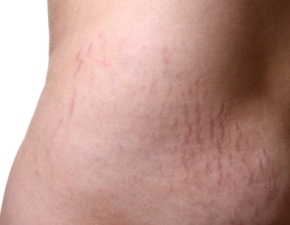Many women have stretch marks, known medically as striae. They occur normally as a result of hormonal changes like those experienced in puberty and pregnancy, and most commonly after weight gain. Knowing that others have the same troubles does little to comfort most women about the unattractive red lines that span their stomachs, hips, thighs or breasts to name just a few commonly affected areas.

Model Photo
Until recently, women had few options for treating their stretch marks. Several devices are now available at your aesthetic physician's office to reduce the appearance of stretch marks and other scars.
The Lux1540 Fractional laser hand piece from Palomar is the first FDA approved fractional laser for the treatment of stretchmarks. Clinical studies have shown that subjects treated with the Lux1540 achieved an average improvement of between 51% and 75% in the appearance of their striae, based upon a blinded review of photographs comparing the pre-treatment appearance of striae versus the results three months post-treatment.
Dr. Vic Narurkar, MD, a dermatologist in San Francisco, CA and past president of the American Society of Cosmetic Dermatology and Aesthetic Surgery says that, "For the right patient, the Lux1540 provides a laser treatment option for stretch marks that offers significant improvement. The non-ablative fractional laser allows for comfortable treatments with little to no impact on the patient's daily activities."
Robert Weiss, MD, director of the Maryland Laser, Skin, and Vein Institute and immediate past president of the American Society for Dermatologic Surgery (ASDS), added, "I have tested many of the available fractional lasers, and Palomar's Lux1540 looks to fulfill a long sought after need for a comfortable treatment with very high patient satisfaction for stretch marks."
There are other options available to patients that physicians say help to improve stretch mark appearance, though they aren't actually FDA approved for that use. Dr. Lori Brightman of the Laser & Skin Surgery Center of New York says, "Stretch marks are difficult to treat. The only proven treatments include fractional lasers, like Fraxel, and fractional bipolar RF, sublative rejuvenation, as well as pulsed dye lasers for the red or pink stretch marks." These technologies can stimulate collagen growth to tighten the skin, making stretch marks look less visible, while also evening out skin tone. Dr. Brightman goes on to say that return visits are necessary. "It requires multiple treatments to help rebuild the collagen," she says.
If you have trouble with your stretch marks, talk to a physician in your area to learn about the available treatments to help reduce the redness and improve the appearance of your skin. The different solutions all have varying recovery times and some are skin color dependent, so it's important to discuss all of your options.